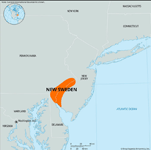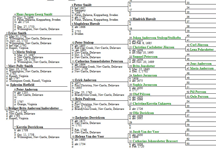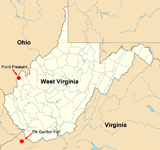The New Sweden line
|
They don't teach us about New Sweden because it was small and short-lived, and its history was less than glorious. In early 1638, an expedition funded by the New Sweden Company and led by Dutchman Peter Minuit (famous for buying Manhattan Island from the Indians for $24 worth of trinkets) traveled up the Delaware River, landed near modern Wilmington, Delaware, negotiated with the Indians to buy some land, and built a settlement that they called Fort Christina. But they hadn't negotiated with the Dutch of New Amsterdam, who considered this area to be part of their territory and didn't appreciate the encroachment. In the 1650s the Dutch became powerful enough to do something about it, and they conquered New Sweden in 1655. The colony had never been very large, with a population that was often less than 200, and wracked with internal dissension. (History, Encyclopedia of Greater Philadelphia)
That wasn't the end of the story however.
New Sweden had lost its independence but still continued to exist as
a Swedish settlement, joined by a large influx of Finns who arrived
on the Mercurius in 1656. The settlement grew to about 400
people. The colony came under English
control after the English conquered the Dutch in 1664. By 1669 the
Scandinavians were dissatisfied enough to launch a rebellion,
alternately called the Revolt of the Long Swede or the Long Finn
Rebellion. It failed of course and English control resumed. Renewed
hostilities between the English and the Dutch resulted in the Dutch
recapturing the area in 1673, but it was returned to
the English in 1674. In 1681 the English formally divided up the
area between the existing English colonies, with parts of the
former Swedish colony going to Delaware, Pennsylvania and New Jersey. The
final insult came in 1682, when the Duke of York transferred control
of the whole region to William Penn. New Sweden was so toothless
that a Quaker could rule them without their consent. (Wikipedia) My New Swedenite ancestors are:
Some of these ancestors are more interesting than others. The more interesting ones are discussed below.
|
|
Johan Andersson Stalcop (abt 1627-bef Feb 1685). Information sources: FamilySearch, Wikitree
The ship's passenger list reportedly describes Johan as a youth who was
hired to go to New Sweden as a farmhand, and he planted tobacco after
arrival. His name was
originally just Johan Andersson. After he became a soldier in 1646 he was
given the nickname Stalkofta (steel coat), which evolved into Stalcop and became the family surname. His career as a soldier lasted until 1655, when New Sweden lost its
independence to the Dutch. He served as a gunner at Fort Trefaldighet during
the Dutch invasion of 1655, but it's not reported that he did any fighting. He became a landowner and the proprietor of a gristmill under Dutch
rule. Johan's future wife Christina Carlsdotter Jonsson had her
own adventure sailing to America.
The Mercurius (carrying about half a dozen of my direct ancestors)
left Sweden in 1655 before it was known that the New Sweden colony had fallen to the
Dutch. When the ship arrived in the New World in 1656, the Swedish territory
was controlled by hostile forces and the Dutch refused permission for the ship to land. After
turning around and starting
to sail for Manhattan as ordered by the Dutch, the ship made contact with the Lenape Indians.
The Lenape had been trading with New Sweden for a long time; they liked the
Swedes and hated the Dutch. The Dutch
feared the Lenape, so the ship turned around again, sailed past the Dutch fort
with their new Lenape friends on deck where the Dutch could see them, and landed in Swedish
territory (Geni).
It would be an act of war if the Dutch fired on the Lenape, so they wisely
let the ship pass. A peaceful
end to the situation was negotiated later. |
|
Jacob Van der Veer (abt
1630-1699) and Catharina
Johansdotter Brassert (aka Catharina Janz Brassert) (abt 1636-1720) Source: Swedish Colonial News Vol 3 #10 Spring 2009, Geni
The story of this pair would make a good plot for a movie. Catharina sailed for the New World on the Gyllene Haj (Golden Shark) in 1654, in a voyage that was plagued by incompetence from beginning to end. The ship was supposed to travel with the Örn but was in such poor condition that it couldn't sail and had to wait for repairs. Finding competent sailors was also a problem, and the original captain was fired before they ever left port. The ship finally set sail for the New World more than two months after the departure of the Örn. Many people became sick on this voyage. New Sweden still had its independence at this time, but incompetent navigation caused the ship to miss the turn into Delaware Bay, and they landed in New Amsterdam instead. This was the very heart of enemy territory, and the Dutch seized the ship and refused to let the passengers leave. Stranded in Manhattan, Catharina met a married Dutch corporal named Jacob Van der Veer and romance bloomed. In 1657 Catharina gave birth to an illegitimate child and was banished to the South River (aka the Delaware River in the former New Sweden territory), probably for adultery. Jacob abandoned his Dutch family to follow her, serving at Fort Christina (originally built by the Swedes). It is not clear whether Jacob and Catharina ever actually married, but they were later considered to be husband and wife. Jacob owned a tavern in the early 1660s but sold it after
he was banished from the area for his insolence toward the court. He then
acquired an island on the Brandywine River after winning a legal dispute with
another claimant. It was renamed Jacob Van der Veer's Island, but it's not
clear whether this island still exists. He built a gristmill (some say a
sawmill) on the island, but his main occupation seems to have been getting
in trouble with the law. He was described as "a troublesome, mutinous"
person who was always challenging authority in addition to always being in
debt. He was once convicted of fraud for selling a bag of feathers with a
stone added to falsify the weight. |
|
Ericus Smith (1734-1792) He was baptized as Ericus Smitt in the Old Swedes Church in Wilmington, Delaware. His first name was given some interesting spellings over the years, for example Eurious, and the last name had spelling variants (frequently Smidt) until he anglicized it to Smith. Everyone knew how to spell it after that. Ericus Smith left the New Sweden area in 1758 with his wife and children. He disappeared from the records for a few years, but was recorded in Virginia starting in 1770. He never left, dying in Russell County in 1792. Ericus has been recognized as a known participant in the first battle of the American Revolution at Point Pleasant (PointPleasantWV.org). The Daughters of the American Revolution (DAR) gave him a listing for it. There are two little problems with this: (1) it wasn't a Revolutionary War battle, and (2) Ericus wasn't there.
Ericus was serving in the Virginia Militia at the time but he was nowhere near the battlefield; he was manning the Elk Garden Fort about 200 miles away. The Sons of the American Revolution have higher standards for listing than the DAR does, and their rules for proving service at Point Pleasant explain that the "official" version is based on a faulty list that includes many men who weren't at the battle. Page 2 of the document specifically rejects the men who were stationed at Elk Garden and several other forts that were far from the battlefield. The actual battle took place at the temporary camp of an army on the move, not at a fort. Elk Garden was one of seven forts built at the
order of Lord Dunmore around July-August 1774 to protect the settlers. There
is no record of it ever being attacked by Indians or anyone else. Ericus was at the fort
from August 13 to November 18, 1774. The muster roll in a
book on Dunmore's war, shows that there were initially 16 men and a sergeant at the
fort, and all but five of the men were discharged on August 29. Ericus was
one of the five who remained; we don't know whether this was voluntary. A
book on the Virginia Militia repeats this information. The muster roll
creates the impression that
finding bread was the main activity at the fort; amusingly,
Wikitree
renders "found bread" as being "found dead". Page 77
(pdf page 81) of
this thesis explains that game was so abundant near the Ohio River that
bread was the only food that needed to be supplied; presumably the same
applied to the forts in western Virginia. Since bread doesn't occur in the
wild, the men of the fort probably found bread by asking the nearby settlers for
it.
|
|
Mary "Polly" Smith and the Hatfield
connection
Women were poorly documented in this time period so
proving the line of descent becomes more difficult at this point; New Sweden
kept excellent records but the English world did not. There is also a name
change to contend with; Polly Smith was baptized as Maria Smidt at the Old
Swedes Church in Wilmington, Delaware in 1754, and this is almost the only
record that we have of her. She was about four years old when the family
left New Sweden. Note: Most sources believe that the Joseph Hatfield who married Rachel Smith was Ephraim Hatfield's father. If this is correct, then Rachel was both the sister-in-law and the stepmother of Ephraim Hatfield. Some sources propose a different relationship between Joseph and Ephraim, but nothing can be proved. In any case, Joseph was old enough to fight in the Revolutionary War and Ephraim was not, so it's very plausible that they were father and son.
|
|
Thomas Smith The documentation for Thomas Smith's connection to the New Sweden line is very weak, but as mentioned in the previous section, I have DNA evidence indicating that it's true. There is no official documentation for Thomas' birth, death, marriage, parents, or siblings, and the name "Thomas Smith" is so common that it's hard to even search for relevant documents. Our only source of written information is Henry Clay
Ragland's "History of Logan County" published in 1896. The
genealogical chapters can be read in
full on the
Logan WV History and Nostalgia website. This book is a
collection of anecdotal information obtained from the
descendants of Logan County's original settlers, long after the
original settlers had died off. The book is notoriously
unreliable - it contains many errors,
and provides demonstrably inaccurate information for several of my ancestors.
But when it's right it's invaluable. Chapter 18 says:
|
|
Other family history articles:
|


